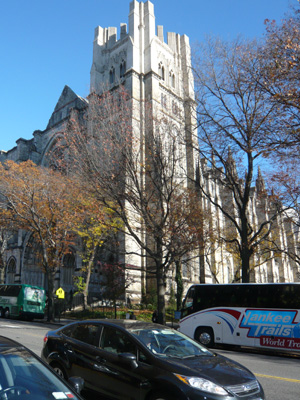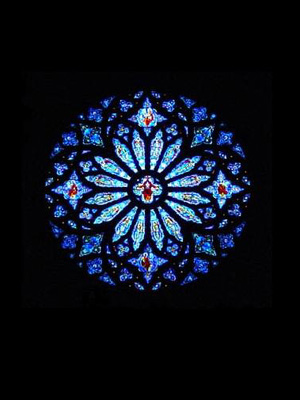| |
 |
 |
 |
| Comment on this report, or find other reports. |
 |
| Our Mystery Worshippers are volunteers who warm church pews for us around the world. If you'd like to become a Mystery Worshipper, start here. |
 |
| Find out how to reproduce this report in your church magazine or website. |
|
|
| 2276: Cathedral
of St John the Divine, New York City |
 |
 |
 |
Mystery
Worshipper: Acton Bell.
The church:
Cathedral
Church of St John the Divine, New York City.
Denomination:
The
Episcopal Church, Diocese
of New York.
The building:
Construction began on the cathedral in 1892 with a Byzantine/Romanesque
design by the firm of Heins and LaFarge, who also designed the
city's first subway stations. In 1911, the firm of Cram, Goodhue
and Ferguson, noted champions of Gothic Revival, were hired
and the design was changed to French Gothic. The first stone
of the nave was laid and the west front was undertaken in 1925,
and the first services in the nave were held the day before
the bombing of Pearl Harbor. Subsequent construction on the
cathedral was halted due to lack of funds and manpower. Construction
has been pretty much halted ever since, and the cathedral remains
unfinished. Almost exactly two and a half football fields in
length, the nave ceiling reaches an astounding 124 feet, and
is the longest Gothic nave in the world, at 230 feet. Seven
chapels radiating from the ambulatory behind the choir are each
in a distinctive nationalistic style, some of them borrowing
from outside the Gothic vocabulary. Known as the Chapels of
the Tongues, their designs are meant to represent each of the
seven most prominent immigrant ethnic groups in New York.
The church:
The cathedral is very active in the community and offers many
social services, including a soup kitchen, emergency intervention
programs, a clothing bank for underprivileged women entering
the workforce, and a multitude of arts programs and concerts,
all of which are detailed on their website. They also house
the Textile Conservation Laboratory, which is a world-class
institution for the conservation of delicate tapestries and
fabrics of antiquity.
The neighborhood:
The cathedral sits on Amsterdam Avenue just north of Cathedral
Parkway (also known as 110th Street). Bishop Horatio Potter,
who had planned the cathedral but did not live to see the cornerstone
laid, had envisioned it as one component of three (Columbia
University and St Luke's Hospital being the other two) that
would form a monument to mind, body and spirit, fit for a modern
city. And while there may be something of the vanity of human
wishes about the whole project, it did spur development in what
was, until then, pastures and farmland. Today, Columbia University
pretty much engulfs the area. There was a plan to develop part
of the cathedral close for a building to be leased to the University,
but the collapse of the real estate market put an end to that.
The cast:
The Revd Canon Thomas P. Miller, STM, canon for liturgy and
the arts, was the officiant and preacher. Kent Tritle, director
of music ministries at the Church of St Ignatius Loyola for
the past 22 years and organist for the New York Philharmonic,
presided at the organ and directed the choir in his capacity
as newly appointed organist and director of music for the cathedral.
The date & time:
Sunday, November 12, 2011, 4.00pm.
What was the name of the service?
Choral Evensong (Rite 1).
How full was the building?
Fourteen in a building that can comfortably hold five thousand.
Did anyone welcome you
personally?
Not really. The usher was busy talking to someone, so I had
to interrupt to get a service bulletin, He didn't seem particularly
happy to be interrupted – even a bit churlish, I thought.
Was your pew comfortable?
I sat in the great choir, which was pretty cool. It is heavily
carved with Green Men, stylized seashells, and important composers,
an incongruous combination that made me chuckle. I was seated
near the figure of who I think was JS Bach standing on the half-shell.
How would you describe the pre-service
atmosphere?
It was very quiet, even still, as there were few if any tourists.
(Usually there is at least one bus load in the building at any
time.) It was also very dim, as the light was fading yet the
electrical lights had not yet been switched on. There was some
lovely half-light coming through the very blue stained glass
windows.
What were the exact opening
words of the service?
Isaiah 57:15 (King James Version): "Thus saith the high
and lofty one that inhabiteth eternity, whose name is holy:
I dwell in the high and holy place..."
What books did the congregation
use during the service?
A very, very complete 16-page service bulletin.
What musical instruments
were played?
The magnificent great organ, Opus 150-A of the venerable Aeolian-Skinner
Organ Company. Badly damaged in the fire that ravaged the north
transept in 2001, this wonderful instrument has been painstakingly
restored by Quimby Pipe Organs of Warrensburg, Missouri. There
was also a choir of eight singers.
Did anything distract
you?
The music was definitely a distraction! It was a mix of English
Baroque, Healy Willan, and Ralph Vaughn Williams – an unexpected
marriage of old and new. The music program at St Ignatius Loyola
under Kent Tritle's direction had come to occupy a major place
in the musical life of the city, and Mr Tritle's influence can
really be heard. It was just fantastic!

Was the worship stiff-upper-lip,
happy clappy, or what?
I know that there are those that think worship at Episcopal
cathedrals as pretty wacky and out-there, but I must say that
this was as pitch-perfect a traditional service as I've ever
been to. And pretty far up the candle to boot. Choral evensong,
Rite 1, with Canon Miller in full choir Dress and one acolyte
in cassock to carry the cross at the procession and recessional.
Exactly how long was the sermon?
14 minutes.
On a scale of 1-10, how good was the preacher?
9 – Canon Miller seemed one of those rare preachers who
can effectively use humor in a sermon both to delight and instruct.
Conversational, without being folksy, he was very engaging.
In a nutshell, what was the sermon
about?
Unpacking the gospel reading, Matthew 25:14-30 (the parable
of the talents), he began by citing a news article where someone
had used the parable as support for the current condition of
the financial services industry. He went on to point out the
error of this reading, in a very funny way, and to point to
how perhaps the Occupy movement might better reflect the parable's
intent.
Which part of the service
was like being in heaven?
Did I mention that the music was really, really fantastic? I
find a good choral evensong to be intensely contemplative. The
choir is doing all the heavy lifting, so to speak. If we're
listening, we can perhaps hear new things in words we (or at
least some of us) say all the time. And one could spend months
studying the many poignant stories behind certain aspects of
the cathedral. For example, I sat directly across from what
is called the World War II Arch. The stonecarver working on
it was called up during the war, and the festoon of trefoils
and flowers remain half done (and will forever remain so).
And which part was like
being in... er... the other place?
A beautiful liturgy in a beautiful space, accompanied by world-class
musicians, all for the benefit of ... a congregation of 14.
(Sigh)
What happened when you hung around after the service looking lost?
There wasn't a coffee hour, but an organ recital by a visiting
organist was scheduled to follow.
How would you describe the after-service
coffee?
I wasn't going to stay for the recital, but the person next
to me saw me getting up to leave and urged me to stay. I said
I would for a bit, and ended up staying for the whole thing.
I was very glad I did.
How would you feel about making this church your regular (where 10 = ecstatic, 0 = terminal)?
9 – With music this good, what is not to like?
Did the service make you feel glad to be a
Christian?
Yes. Here was a traditional service that was so unfussy and
unpretentious, at once clearly plugged into the past and forward
looking.
What one thing will you remember about all this in seven days' time?
The World War II arch, and that perhaps there is a lesson there
in things left undone. |
|
|
 |
 |
 |
| We rely on voluntary donations to stay online. If you're a regular visitor to Ship of Fools, please consider supporting us. |
 |
 |
 |
| The Mystery Pilgrim |
 |
| One of our most seasoned reporters makes the Camino pilgrimage to Santiago de Compostela in Spain. Read here. |
 |
 |
 |
| London churches |
 |
| Read reports from 70 London churches, visited by a small army of Mystery Worshippers on one single Sunday. Read here. |
| |
|
|
|
|


